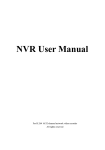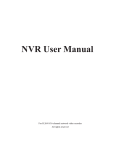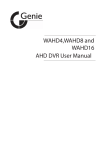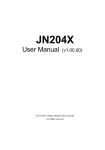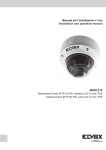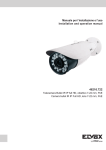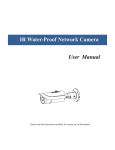Download IP-CAMERA USER MANUAL
Transcript
IR Water-proof Network Camera User Manual Please read this instruction carefully for correct use of the product Before use this product Before operation, we strongly advise users to read this manual and keep it properly for using later. Please use the specified power supply to connect. Avoid from in correct operation, shock vibration, heavy pressing which can cause damage to product. Do not use corrosive detergent to clean main body of the camera. If necessary, please use soft dry cloth to wipe dirt; for hard contamination, use neutral detergent. Any cleanser for high grade furniture is applicable. Avoid aiming the camera directly towards extremely bright objects, such as, sun, as this may damage the image sensor. Please follow the instructions to install the camera. Do not reverse the camera, or the reversing image will be received. Do not operate it incase temperature, humidity and power supply are beyond the limited stipulations. Keep away from heat sources such as radiators, heat registers, stove., etc. This is product instructions not quality warranty. We may reserve the rights of amending the typographical errors, inconsistencies with the latest version, software upgrades and product improvements, interpretation and modification. These changes will be published in the latest version without special notification. When this product is in use, the relevant contents of Microsoft, Apple and Google will be involved in. The pictures and screenshots in this manual are only used to explain the usage of our product. The ownerships of trademarks, logos and other intellectual properties related to Microsoft, Apple and Google belong to the above-mentioned companies. This manual is suitable for IR water-proof network camera. All pictures and examples used in the manual are for reference only. IP CAMERA USER MANUAL Table of Contents 1 2 3 4 5 Introduction ...................................................................................................................... 1 1.1 Summarization ................................................................................................................. 1 1.2 Check Package Content .................................................................................................. 1 1.3 Overview.......................................................................................................................... 2 Installation .............................................................................................................3 2.1 Install IP-CAM .......................................................................................................... 3 2.2 Install CMS ............................................................................................................... 4 IE Remote Access ...................................................................................................5 3.1 LAN ................................................................................................................................. 5 3.1.1 Access through IP-Tool .................................................................................... 5 3.1.2 Directly Access through IE ................................................................................... 6 3.2 WAN................................................................................................................................. 7 Remote Preview ......................................................................................................9 4.1 The Remote Preview Interface ....................................................................................... 9 4.2 Playback ........................................................................................................................... 9 4.3 Snap Pictures ................................................................................................................. 10 Remote Live Surveillance ...................................................................................... 12 5.1 System Configuration ................................................................................................... 12 5.1.1 Basic Information ................................................................................................ 12 5.1.2 Date & Time Configuration ................................................................................ 12 5.2 Video Configuration ...................................................................................................... 13 5.2.1 Camera Configuration ......................................................................................... 13 5.2.2 Video Stream ....................................................................................................... 14 5.2.3 OSD Configuration ............................................................................................. 14 5.2.4 Video Mask .......................................................................................................... 15 5.2.5 ROI Configuration............................................................................................... 16 5.3 Alarm Configuration ..................................................................................................... 17 5.3.1 Motion Detection Area ........................................................................................ 17 5.3.2 Motion Detection Trigger ................................................................................... 17 5.3.3 Motion Detection Schedule ................................................................................ 18 5.4 Network Configuration ................................................................................................. 19 5.4.1 Port ....................................................................................................................... 19 5.4.2 IP Address ............................................................................................................ 19 5.4.3 Server Configuration ........................................................................................... 20 5.4.4 IP Notify ............................................................................................................... 20 5.4.5 DDNS Configuration .......................................................................................... 21 5.4.6 RTSP .................................................................................................................... 22 5.4.7 UPNP.................................................................................................................... 22 5.4.8 Mail Setting ......................................................................................................... 22 5.4.9 FTP ....................................................................................................................... 23 5.5 Advanced Configuration ............................................................................................... 24 5.5.1 User Configuration .............................................................................................. 24 IP CAMERA USER MANUAL 6 7 5.5.2 Security Configuration ........................................................................................ 25 5.5.3 Configure Backup & Restore ............................................................................. 26 5.5.4 Reboot Device ..................................................................................................... 26 5.5.5 Upgrade ................................................................................................................ 27 Q & A ................................................................................................................... 28 Specification .........................................................................................................30 Page 1 IP CAMERA USER MANUAL 1 Introduction 1.1 Summarization This IP-CAMERA (short for IP-CAM) is designed for high performance CCTV solutions. It adopts state of the art video processing chips. It utilizes most advanced technologies, such as video encoding and decoding technology, complies with the TCP/IP protocol, SoC, etc to ensure this system more stable and reliable. This unit consists of two parts: the IP-CAM device and central management software (short for CMS). The CMS centralizes all devices together via internet or LAN and establishes a sound surveillance system to realize unified management and remote operation to all devices in one network. This product is widely used in banks, telecommunication systems, electricity power departments, law systems, factories, storehouses, uptowns, etc. In addition, it is also an ideal choice for surveillance sites with middle or high risks. Main Features 3MP(2048 x 1536)full real time coding Max. resolution: 2048 x 1536 ICR auto switch, true day/night 20 ~ 30m IR night view distance 3D DNR, digital WDR ROI coding Support one-way audio and PoE power supply Support smart phone, iPad, remote monitoring Support P2P (NET Traversal) 1.2 Check Package Content Camera Quick Start Guide CD Template Screws 网络摄像机 快速安装指引 Name Description Camera The device Quick Start Guide Tell you how to use the camera quickly CD Including user manual, quick start guide, IP-Tool, CMS,etc. Drill Template For installation Screws For installation Page 2 IP CAMERA USER MANUAL 1.3 Overview 4 5 6 1 2 3 1 Lens 3 Mounting Base 5 Power Cable 2 Fixed Ring 4 Audio In 6 Network Cable Cable Connections N etw o rk Cab le Ne tw ork Ca b le Internet N etw o rk Cab le N e tw o rk C a bl e N etw o rk Cab le Page 3 IP CAMERA USER MANUAL 2 Installation 2.1 Install IP-CAM Before you start, please make sure that the wall is strong enough to withstand three times the weight of the camera. The mounting steps are as follows: ① Drill the screw holes and the cable hole on the wall according to the drill template. ② Route the cables and connect the audio cable, power cable and network cable. ③ Secure the mounting base with camera to the wall with screws as shown below. Wall ④ Bracket adjustment. Before adjustment, preview the image of the camera on a monitor and then loosen the fixed ring to adjust the view angle of the camera. 360° Pan 90° Tilt ⑤ Focus and zoom adjustment ( If the model you get is prime lens, please skip this step). Remove the lens cover and then adjust the focus and zoom screws to get a clear image. Finally, tighten these two screws and the lens cover. Page 4 IP CAMERA USER MANUAL Lens Cover Zoom Focus ⑥ Remove the protection film softly to finish the installation. 2.2 Install CMS Find CMS software from CD and then double click “Setup.exe” file to pop up installation wizard. Install the software according to the prompts in the wizard. After you complete the installation, you will see the CMS and IP-Tool icon on the desktop. Please see the user manual of this software for more details. If you need to install IP-Tool separately, please double click IP-Tool installation package and install it according its wizard prompts. After you finish installing, double click IP-Tool icon to start IP-Tool. Page 5 IP CAMERA USER MANUAL 3 IE Remote Access You may connect IP-Cam via LAN or WAN. Here only take IE browser (6.0) for example. The details are as follows: 3.1 LAN In LAN, there are two ways to access IP-Cam: 1. access through IP-Tool; 2. directly access through IE browser. 3.1.1 Access through IP-Tool ① Make sure the PC and IP-Cam are connected to the LAN and the IP-Tool is installed in the PC from the CD. ② Double click the IP-Tool icon on the desktop to run this software as shown below: ③ Modify the IP address. The default IP address of this camera is 192.168.226.201. Click the information of the camera listed in the above table to show the network information on the right hand. Modify the IP address and gateway of the camera and make sure its network address is in the same local network segment as the computer’s. Please modify the IP address of your device according to the practical situation. For example, the IP address of your computer is 192.168.13.4. So the IP address of the camera shall be changed to 192.168.13.X. After modification, please input the password of the Page 6 IP CAMERA USER MANUAL administrator and click “Modify” button to modify the setting. The default password of the administrator is “123456”. ④ Double click the IP address and then the system will pop up the IE browser to connect IP-CAM. IE browser will auto download the Active X control. After downloading, a login window will pop up as shown below. Input the username and password to log in. The default username is “admin”; the default password is “123456”. 3.1.2 Directly Access through IE The network service is default as shown below: IP address: 192.168.226.201 Subnet Mask: 255.255.255.0 Gateway: 192.168.226.1 HTTP: 80 Data port: 9008 You may use the above default settings when you log in the camera for the first time. ① Manually set the IP address of the PC and the network segment should be as the same as the default settings of the IP camera. Open the network and share center. Click “Local Area Connection” to pop up the following window. Page 7 IP CAMERA USER MANUAL Select “Property” and then select internet protocol according to the actual situation (for example: IPV4). Next, click “Property” button to set the network of the PC. ② Open the IE browser and input the default address of IP-CAM and confirm. The IE browser will download Active X control automatically. ③ After downloading Active X control, the login dialog box will pop up. ④ Input the default username and password and then enter to view. 3.2 WAN Take access the camera by the router or virtual server for example ① Make sure the camera is well connected via LAN and then log in the camera via LAN and go to the ConfigNetwork ConfigPort menu to set up the port number. Page 8 IP CAMERA USER MANUAL ② Go to Config Network ConfigIP Address menu to modify the IP address. ③ Go to the router’s management interface through IE browser to forward the IP address and port of the camera in the “Virtual Server”. Port Setup IP Setup Router Setup ④ Open the IE browser and input its WAN IP and http port to access. Page 9 IP CAMERA USER MANUAL 4 Remote Preview 4.1 The Remote Preview Interface 1 People icon 5 Zoom out 9 Snap 2 Fix size 6 Full screen 10 Audio 3 Actual size 7 Start recording 4 Zoom in 8 Playback When motion detection alarm is triggered, the people icon turns red. Right click to pop up a pull-down list as shown below: Stream: Three streams are optional. Turn off the live: Click this item will close present live preview. Enable audio: Click this item will open audio. Full screen: The live preview picture will full-screen display. Double click or click right mouse to return to the previous interface. Online user: Display the current user connecting to the device. System information: Display the device information: device name, firmware version, software build date, kernel version and hardware version. 4.2 Playback Before you play the record files, please make sure you have recorded. You make click button to record. Then click button to pop up a video player. Double click the record file to play the video as shown below. Page 10 IP CAMERA USER MANUAL 1 Play 5 Next frame 9 Zoom out 2 Pause 6 The previous file 10 Full screen 3 Stop 7 The next file 11 Path 4 Forward 8 Zoom in 12 Volume 4.3 Snap Pictures Select the picture number, and then click “Snap” icon as shown below: Single Snap Snap multiple pictures Select the picture number from Frame pull down list box, such as 2, and check “Title” and “Time” to show capture title and time on the snap pictures simultaneously. Page 11 IP CAMERA USER MANUAL Multi-picture Snap Page 12 IP CAMERA USER MANUAL 5 Remote Live Surveillance Functions of remote configurations include: System Configuration, Video Configuration, Alarm Configuration, Network Configuration and Advanced Configuration. You should firstly select the menu on the left, and then set up the relative parameters. When one user configures parameters of a certain device, other users can not set up this device. 5.1 System Configuration The “System configuration” includes two submenus: Basic Information and Date & Time. 5.1.1 Basic Information In the “Basic Information interface, you can set up the device name and can also check the relative information of the server Setting steps: 1. Clicking the "Config" icon will appear the menu list. 2. Clicking the “Basic Information "will pop up a window as shown below: 3. Input the name of the device in the "Device name" text box. 4. Press the "Save" button to save the settings. Please refer to the following table for parameters and instructions of server basic configuration. Parameter Meaning Software version The software of the device Software build date The software build date of the device Kernel version The kernel version of the device Hardware version The hardware version of the device Mac Address MAC address of device Maximum number of user Support max 4 users to access Device name Name of the device. 5.1.2 Date & Time Configuration Setting steps: 1. Go to ConfigDate & Time menu as shown below. Page 13 IP CAMERA USER MANUAL 2. Set time zone. 3. Enable DST mode as required. 4. Set time. You may set time manually or enable NTP. 5.2 Video Configuration Camera Configuration includes five submenus: Camera Configuration, Video Stream, OSD Config, Video Mask and ROI Config. 5.2.1 Camera Configuration Setting steps: 1.Go to "Video Configuration " "Camera" interface as shown below. 2. You may adjust brightness, contrast, hue and saturation of the picture. 3. Select white balance mode. 4. Wide dynamic, sharpen and denoise are adjustable. 5. You can also set day-night mode and enable the image mirror and image flip function. 6. Frequency are adjustable. 7. You may repair bad pixel. 8. Press the "Save" button to save the settings. Page 14 IP CAMERA USER MANUAL 5.2.2 Video Stream Go to "Video configuration" "Video Stream" to see an interface as shown below. Three video streams can be adjustable. Resolution: The higher the resolution is, the clearer the image is. Frame rate: The higher the frame rate is, the more fluency the video is. However, more storage room will be taken up. Bitrate type: Including CBR and VBR. CBR means that no matter how changeable the video resources are, the compression bitrate keeps constant. This will not only facilitate the image quality better in a constant bitrate but also help to calculate the capacity of the recording. VBR means that the compression bitrate can be adjustable according to the change of the video resources. This will help to optimize the network bandwidth . Video Quality: When VBR is selected, you need to choose image quality. The higher the image quality you choose, the more bitrate will be required. Bitrate: Please choose it according to the actual network situation. I Frame Interval: It is recommended to use the default value. If the value is over high, the read speed of the group of pictures will be slow resulting in the quality loss of the video. Video encoding profile: Baseline and main profile are optional. Baseline profile is mainly used in interactive application with low complexity and delay. Main profile is mainly used for higher coding requirement. Alarm picture size: Please select it according to the actual situation. Video encode slice split: If enabled, you may get more fluency image even though using the low-performance PC. Audio Encoding: G.711A and G.711U optional. Audio In Type: MIC and LIN optional. 5.2.3 OSD Configuration Go to “Video Config” “OSD Config” menu to display the interface as shown below. Page 15 IP CAMERA USER MANUAL You may set time stamp, device name and custom OSD here. Drag the time stamp and custom OSD to set their position. Then press the "Save" button to save the settings. 5.2.4 Video Mask You can set 4 mask areas at most. To set up video mask 1. Enable video mask and select mask color. 2. Click “Draw” button and then drag the mouse to draw the video mask area. 3. Click “Save” button to save the settings. 4. Return to the live to see the following picture. Page 16 IP CAMERA USER MANUAL Clear the video mask: Go to video mask menu and then click “Clear” button to delete the current video mask area. 5.2.5 ROI Configuration To set up ROI 1. Go to ConfigROI Config menu. 2. Check “Enable” and then click “Draw” button. 3. Drag the mouse to set the ROI area. 4. Set the level. 5. Click “Save” button to save the settings. Now, you will see the selected ROI area is clearer than other areas especially in low bitrate condition. Page 17 IP CAMERA USER MANUAL 5.3 Alarm Configuration Alarm configuration includes three submenus: Motion Detection Area, Motion Detection Trigger and Motion Detection Schedule. 5.3.1 Motion Detection Area 1. Go to “Alarm configuration""Motion Detection Area" to see an interface as below. 2. Move the "Sensitivity" scroll bar to set up the motion trace sensitivity. 3. Check the "Add”, press the "Ctrl" button and move mouse to select the motion detection area. Select “Erase” and move the mouse to clear all motion detection area. 4. Press the "Save" button to save the settings. 5.3.2 Motion Detection Trigger 1. Go to “Alarm Configuration" "Motion Detection Trigger" to display an interface as shown below. 2. Check "Enable alarm" check box. Then all functions under this interface will be activated. 3. Trigger Email: Check “Attach picture” and select email addresses in the “Receival email address” text box(Email address shall be set first in the Mail config interface).Then the triggered snap pictures will be sent into those address. User also can define the subject and content of the email. Page 18 IP CAMERA USER MANUAL 4. Trigger FTP: Check “Uploading picture”. Then the triggered snap pictures will be sent into FTP server address. Please refer to FTP configuration chapter for more details. 5. Press the "Save" button to save the settings. 5.3.3 Motion Detection Schedule Go to “Alarm configuration" "Motion Detection schedule" interface as shown below. Week schedule User could set the alarm time from Monday to Sunday for alarm everyday in one week. "Add": Add the schedule for a special day. "Erase": Delete holiday schedule Page 19 IP CAMERA USER MANUAL Day schedule You could set alarm time for alarm in some time of special day, such as holiday. 1. Select a date at the "Date" pull down list, press "Add" button to add that date to the list box on the right side and then move the scroll bar to set the schedule of that day. 2. Select a date in the list box on the right side, and press "Erase" to remove the schedule on that day. Press the "Save" button to save the settings. Note: Holiday schedule is prior to Week schedule. 5.4 Network Configuration Network configuration includes nine menus: Port, IP Address, Server Configuration, IP Notify, DDNS Config, RTSP, UPNP, Mail Setting and FTP Setting. 5.4.1 Port 1. Go to "Network config""Port" to see the interface as shown below. 2. Input port number for IE access in the "HTTP Port" textbox. 3. Input the port number for audio & video transmission in the "Data Port" textbox. 5.4.2 IP Address 1. Go to "Network Configuration""IP Address" to see a tab shown below. Page 20 IP CAMERA USER MANUAL 2. There are two options for IP setup: obtain an IP address auto by DHCP protocol and use the following IP address. You may choose one of options as required. 3. Use the following IP address: display the IP address, subnet mask and gateway. There are two options for DNS: obtain DNS server address automatically and use the following DNS server. 4. PPPOE: User needs to manual input the user name and password for dial-up internet. Firstly, log in IE clients and then enter user name and password of PPPoE, save the setting and exit. Secondly, set up IP address change notice. Thirdly, connect with Modem. Then the device will dial up internet automatically. 5. Press the "Save" button to save the settings. 5.4.3 Server Configuration Go to “Network Configuration” “Server Config”. 1. Check “Do you want IP Camera to connect Server. 2. Check the IP address and port of the transfer media server in the CMS/NVMS. Then enable the auto report in the CMS/NVMS when adding a new device. Next, self-define the device ID and input the remaining information of the device in the CMS/NVMS. 3. Input the above-mentioned server IP, server port and device ID in the responding boxes. 4.Click “save” button to save the settings. 5.4.4 IP Notify 1. Go to “Network Configuration””IP Notify” to see a tab as shown below. 2. If the “Enable notifying change of IP” is selected, when the IP address of the device is changed, a new IP address will be sent to the appointed mailbox automatically; If “FTP” is selected, when the IP address of the device was changed, a new IP address will be sent to FTP server. Page 21 IP CAMERA USER MANUAL 5.4.5 DDNS Configuration 1. Go to "Network Configuration""DDNS Configuration" tab as shown below. 2. Apply for a domain name. Take WWW. dvrdydns.com for example. Input www.dvrdydns.com in the IE address bar to visit its website. Then click “Registration” button to register as shown below. Create domain name. After you successfully request your domain name, you will see your domain in the list. Page 22 IP CAMERA USER MANUAL 3. Select the server type and then input the username, password and domain name you apply for in the DDNS configuration interface. 4. Click “Save” button to save the settings. 5.4.6 RTSP Go to “Network Configuration” “RTSP” interface as shown below. 1. Select “Enable RTSP server. 2. RTSP Port: Access Port of the streaming media. The default number is 554. 3. RTSP Address: The RTSP address you need to input in the media player. 4. You can also choose to enable anonymous viewer login 5.4.7 UPNP Go to “Network Configuration” “UPNP” interface as shown below. Select “Enable UPNP” and then input friendly name. Then double click “Network” icon on the desktop of the PC to see an icon with the friendly name and IP address of the camera. You may quickly access the device by double clicking this icon. 5.4.8 Mail Setting Go to “Network Configuration” “Mail Setting” interface. Page 23 IP CAMERA USER MANUAL 1. From Email: sender’s e-mail address 2. User name and password: sender’s user name and password 3. Server address: SMTP name of sender 4. Select the secure connection type at the Secure Connection pull down list according to user’ actual needs 5. Receival email address list: add email address into the list 6. Receival email address: receiver’s e-mail address 7. After all parameters set up, you can click “Test your account settings”. If email sent successful, a “Test Successful” window will pop up, if not, users can try other email addresses or check the setting. Notice: If you change the static IP into PPPoE and select mailbox, there will be an e-mail sent to your mail box for notifying a new IP address. 5.4.9 FTP Go to Network ConfigurationFTP interface as shown below. 1. Add: Click Add button to input FTP server’s server name, address, port number, user name, password, and upload path, click OK to confirm the setting. 2. Modify:Click this button to change some information of the FTP server 3. Delete:Select certain FTP account; Click this button to delete this account 4. Test :Select certain FTP account; Click this button to test its valid or not. Please refer to the following table for parameters and instructions of FTP configuration. Page 24 IP CAMERA USER MANUAL Parameter Meaning Server name The name of the FTP server Server address The address of the FTP server Port The port number of the FTP server User name The user name of the FTP server Password The password of the FTP server Path The save path for FTP files 5.5 Advanced Configuration Advanced configuration includes five submenus: User Configuration, Security Configuration, Configure Backup & Restore, Reboot and Upgrade. 5.5.1 User Configuration Go to "User Configuration" interface. Add user: 1. Clicking "Add" button pops up "Add user" dialog box. User Configuration Add User Note: After binding physical address to the IP-CAM, you can access the device on this PC in network only. If the MAC address was ““00:00:00:00:00:00” which means it can be connected to any computers. 2. Input user name in "User Name" textbox (only letters). 3. Input characters in "Password" and "Confirm Password" textbox (letters or numbers). 4. Input the MAC address of the PC in "Binding MAC address" textbox. 5. Click “OK” button and then the new added user will display in the user list. Modify user: 1. Select the user which needs to modify password and physical address in the user configuration list box. 2. Clicking “Modify” button will pop up “Modify user” dialog box as shown below. Page 25 IP CAMERA USER MANUAL Modify User 3. Input original password of this user in the “password” text box. 4. Input new password in the “New password” and “Confirmation” text box. 5. Input computer’s physical address which is used to access the server in the “User PC MAC” text box. 6. Click “OK” button to modify password and binding MAC address successfully. Delete user: 1. Select the user which needs to delete in the user configuration list box. 2. Clicking “Delete” button will pop up a confirm dialog box. Then click “OK” to delete the user. Note: The default super administrator cannot be deleted. Parameter Meaning User Name User name to operate the logon client end User Type Type of users, normal user, advanced user and super administrator Binding MAC address The MAC addresses of user access the server which should set up according to actual MAC address of server. Password Password to log in the client terminal Confirm Password Password to log in the client terminal 5.5.2 Security Configuration 1. Go to Advanced ConfigurationSecurity Configuration to see a tab shown below. 2. Check “Enable IP address” check box, select “Deny the following IP address”, input IP address in the IP address list box and click “Add” button. Then this IP address will display in the list box; the operation step of “Allow the following IP address” is the same with “Deny the following IP address” 3. Select the IP address which needs to be deleted from the IP address list box and click “delete” button to delete that IP address. 4. Check “Enable MAC address” check box, select “Deny the following IP address”, input MAC address in the MAC address list box and click “Add” button. Then this MAC address will display in the list box; the operation step of “Allow the following MAC address” is the same with “Deny the following IP address”. Page 26 IP CAMERA USER MANUAL 5. Select the MAC address which needs to be deleted from the MAC address list box and click “delete” button to delete that MAC address. 6. Click "save" button to save the above setting. 5.5.3 Configure Backup & Restore Go to Advanced configurationConfigure Backup & Restore Interface. Import & Export Configuration: You can import or export the setting information from PC or to device. 1. Click “Browse” to select save path for import or export information on PC. 2. You can import or export all setting information to PC, but those two settings “User Configuration” and “Network Configuration” are exceptional. Default Configuration Click “Load default” button to restore all system settings to the default status. 5.5.4 Reboot Device Go to Advanced configuration—Reboot device to see an interface as shown below Click “Reboot device” button to reboot the device. Page 27 IP CAMERA USER MANUAL 5.5.5 Upgrade Go to Advanced Configuration—Upgrade interface as shown below. 1. Click “Browse” button to select the save path of the upgrade file 2. Click “Upgrade server firmware” button to start upgrading the application program 3. The device will restart automatically 4. After you successfully update the software, click “OK” button to close IE and then re-open IE to connect IP-Cam. Notice: You can’t disconnect to PC or close the IP-CAM during upgrade. Page 28 IP CAMERA USER MANUAL 6 Q&A Q: How to find my password if I forget it? A:Reset the device to the default factory settings Default IP: 192.168.226.201 User name: admin Password: 123456 Q:Fail to connect devices through IE browser, why? A: Network doesn’t connect well. Please check the connection and make sure it connected well. B: IP is not available. Reset the valid IP. C: Web port number has been revised: contact administrator to get the correct port number. D: Exclude the above reasons. Recover default setting by IP-Tool. Note: Default IP: 192.168.226.201,mask number: 255.255.255.0 Q:IP tool cannot search devices, why? A:It may be caused by the anti-virus software in your computer. Please exit it and try to search device again. Q:IE cannot download ActiveX control. How can I do? a. IE browser blocks ActiveX. Please do setup following below. ① Open IE browser. Click Tools-----Internet Options…. ② Select Security------Custom Level…. ③ Enable all the sub options under “ActiveX controls and plug-ins”. Page 29 IP CAMERA USER MANUAL ④ Then click OK to finish setup. b. Other plug-ins or anti-virus blocks ActiveX. Please uninstall or close them. Q:No sound can be heard, why? A:Audio input device is not connected. Please connect and try again. B: Audio function is not enabled at the corresponding channel. Please check AUDIO item to enable this function. Q:Why doesn’t the device connect to wireless? A: Check the statues of wireless router. Please make sure the router is open. B: Check the router and the device port. Page 30 IP CAMERA USER MANUAL 7 Specification Model Camera Image 3 Megapixels IR Water-proof Bullet Network Camera Image Sensor 1/3“CMOS Image Size 2048 x 1536 Electronic Shutter 1/25s~1/100000s Auto Iris Fixed Iris Min. Illumination 0 Lux (IR ON) Lens 6mm (4mm, 8mm optional) Day-Night Switch ICR auto switch WDR Digital WDR DNR 2D/3D noise reduction Video Compression H.264/MJPEG H.264 Compression Baseline Profile/Main Profile/High Profile Encode Mode VBR/CBR Image Quality Five levels VBR; Freely adjustable under CBR Bitrate ROI 64Kbps~8Mbps 3MP ( 2048×1536 )、 1080P ( 1920×1080 )、 720P (1280×720) 、D1、CIF、480x240 3MP(1~30fps) / 1920x1080(1~30fps) 1280x720(1~10fps) / D1(1~30fps) / CIF(1~30fps) CIF(1~30fps) / 480x240(1~30fps) ROI coding, Saturation, Brightness, Chroma, Contrast, Wide Dynamic, Sharpen, NR., etc., adjustable through client software or web browser Support Network RJ45 Audio One-way audio ( MIC IN x 1 ) Remote Monitoring Interface Protocol IE browsing, CMS remote control Support simultaneous monitoring for up to 10 users; Support multi-stream real time transmission TCP/IP, UDP, DHCP, NTP, RTSP, PPPoE, DDNS, SMTP, FTP ONVIF, GB-T/28181-2011 Storage Network remote storage Smart Alarm Motion Alarm PoE Power Supply Support IR Distance 20 ~ 30 m Water-proof IP66 Power Supply DC12V/PoE Power Consumption < 4W (ICR OFF); <7W(ICR ON) Working Environment -40℃~50℃, 10%~90% humidity Dimension Φ 87mm × 219mm Weight(Net) 621g Resolution Multi-streams Image Settings Interface Online Connection Network Protocol Function Others A0









































